
The whiter the image, the hotter the area.
Recently, I found myself back on the roof of a shed I hadn’t worked on for at least a dozen years. The solar hadn’t gone anywhere, but damn, it needed a clean.
These days I have a thermal camera to play with and a passing interest in how real world solar installs are coping with age. I’m happy to report this one was working well enough but the owner was wailing about a growing electricity bill. Owing to an annual rainfall of 800mm and an almost invisible installation, other things were growing unnoticed on the array.
It Was Quite A Trip
I was reminiscing in more ways than one. This was a roof I’d fallen through while helping erect the building in the first place. How? I committed my weight to stepping on a roof sheet that didn’t have any screws in it, which responded by standing up vertical, and allowing me to pass gracelessly through the frame.
“D’ya remember that!?” chuckled my old mate… Well yes; I’ll never forget landing on a screw gun, that hurt, but I particularly remember the laughter, and concern about denting the sheet of roofing iron. Hilarious it was.
Maintenance Time
This time around I was sucked into helping replace some cracked plastic skylight sheets, but we managed that work without any safety breaches.
While I was there I had a quick glance over the 3.33kW array. Originally consisting of 10 Sungrid branded panels, it was quickly expanded with 8 genuine Australian Made units from Silex.
Australia Was A World Leader In Solar
BP Solar used to run a complete solar panel manufacturing facility in Sydney, unlike Tindo Solar‘s current solar panel factory in Adelaide, it was a full end-to-end ingot, wafer, and panel operation.
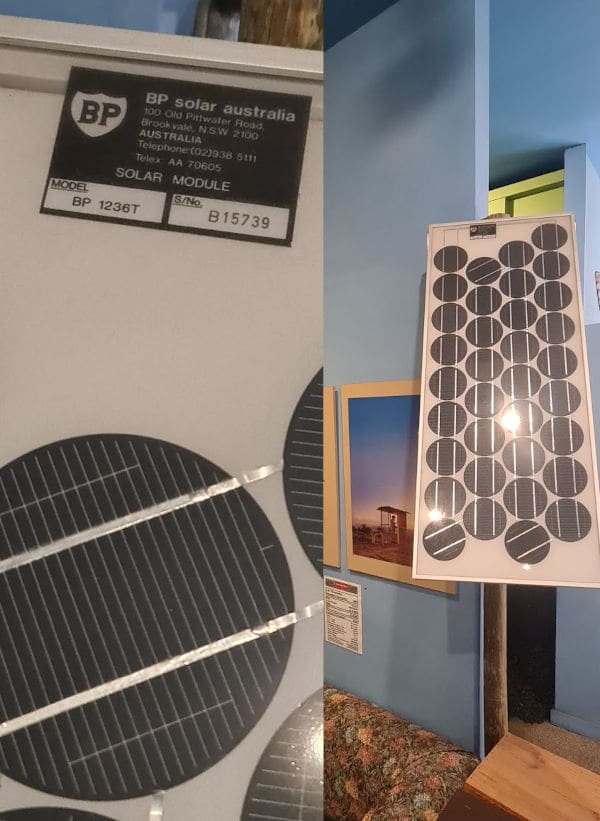
BP Solar Australia. It’s not just car manufacturing we’ve given up. This one is preserved in a museum in Port Augusta SA
It was the glory days when the new Sydney Olympic Village had Australian made panels on the roof, and our esteemed leaders spent ten times the research and development money on “clean coal1” than they did on renewables.
While BP used to supply panels for the iconic Telecom outback phone boxes, China had decided they should own the worldwide renewable industry. Our little plant soon became an uncompetitive tiddlywink in scale. After BP sold out, Silex took over for a while, but sadly it didn’t last.

Telecom phone boxes at Innaminka. Image credit to Solar Depot for sending me there to see them
At least, today, we punch above our weight in terms of rooftop solar installation.
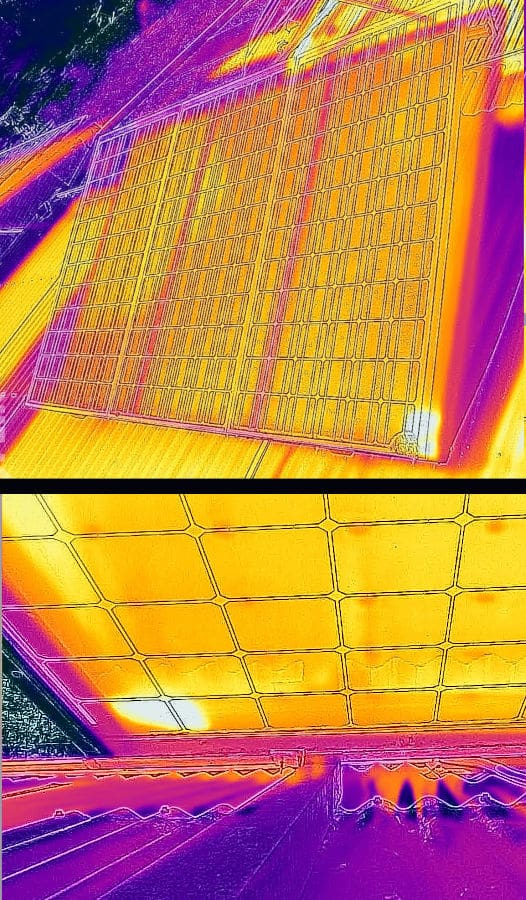
White = hot: viewed from the top or underneath, the panel from our cover image has a hot cell due to lichen growing across it
Hot Damn, There’s A Real Need For Cleaning
As the cover image shows, what looks like a fairly benign little patch of greenery really does affect the running temperature of a solar cell.
By blocking the light on this one cell, all of the others in this series have to force their electrons through an unproductive wafer.
For this example, a third of the panel will be affected, and the diodes in the junction box where the 3 strings of cells are connected will also be labouring to allow the rest of the panel to bypass the problem.
This excess heat is obviously wasted energy, but it will also shorten the cell’s life and damage overall output in the long term.
Happily, in this case, the cell didn’t take long to cool off once the offending growth was removed.
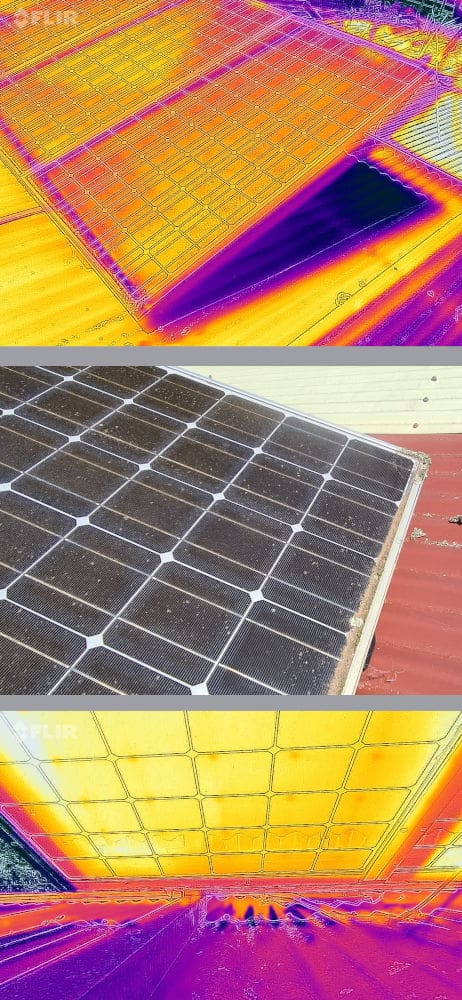
Simply scratching the bulk of the lichen off with my pocket knife was enough to make the difference.
Taking A Different View
Although these images are only taken with a basic $600 phone attachment2 the motivating impact they have on customers and installers is priceless.
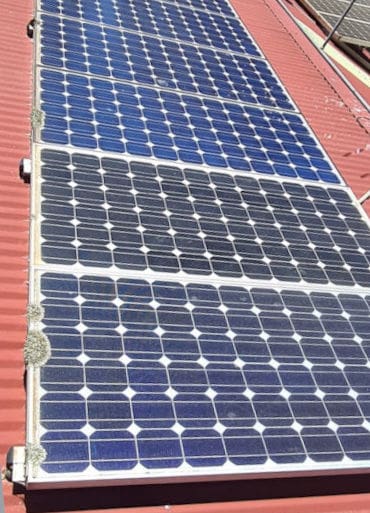
The lichen on this array looks pretty benign to the naked eye
Thermal cameras continually tune themselves to show contrast. In any given frame, there may be 10 degrees or 100 degrees difference in surface temperature.
The colours displayed don’t represent a particular number, but the coldest surface will be displayed as a dark patch, while the warmest is white hot, so to speak.
Better cameras put numbers on a scale to indicate actual temperature, but the latest software update seems to have removed that setting from my gadget.

Here we see the same array with a couple of dogs’ bollocks on show; out of hundreds of cells; they really shine here.
For the best results, the sky is literally the limit. Commercial operators will outlay $15,000 or more on a high resolution camera and drone package.
Still, the expense is easily justified when you have thousands upon thousands of panels to inspect at a solar farm. And of course, drones are very handy for a domestic system on a difficult two story house.
Beware Of Solar Panel Cleaner’s Claims
When the dirt is so thick you can’t see the cells, cleaning is essential, however some solar panel cleaners are prone to exaggerating how much yield you can restore to a system simply by removing a transparent layer of grime.
If they have a photo of an inverter display showing 30% more power, it’s probably just because they’ve cooled the panels with water.
Provided the array has 10 degrees pitch or more, it’s likely to clean itself in the rain.
Under no circumstances should cleaning involve walking on the glass or using a pressure washing machine.
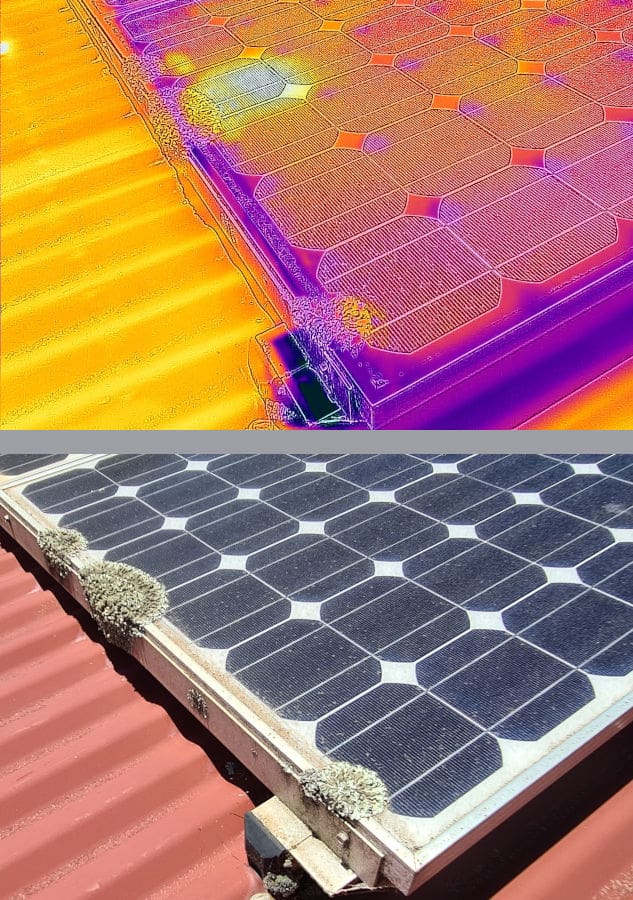
It’s interesting to see how little coverage causes a cell to heat up
5 Years Is Fine
My general advice is to engage a qualified solar company to clean and inspect your solar system as often as you like.
Remember though, as a small embedded generator, you’re obliged to have the system checked to ensure safety. The agreement you have with the poles and wires authority normally stipulates 5 year intervals but I’ve never heard of any audits being done.
Hard Shade Should Be Avoided
Though it may not look significant, the takeaway message here is simply that shadows are not good for solar cells. Whether it’s from bird droppings, leaves, and lichen, or worse still, from stink pipes, aerials, or other obstacles, the best output and longest life comes from eliminating hard-line shade.
Footnotes
- How good is clean coal though..? Reminds me of a famous passage by Donald Horne that nobody ever quotes in full. Australia is a lucky country run mainly by second rate people who share its luck. It lives on other people’s ideas, and, although its ordinary people are adaptable, most of its leaders (in all fields) so lack curiosity about the events that surround them that they are often taken by surprise. ↩
- I’m sure there are half price knockoff thermal cameras by now ↩

 RSS - Posts
RSS - Posts



Can you use chemicals to kill the lichen ?
Hi David,
Probably can use chemicals but I know first hand that some herbicides are exceptionally aggressive on metals. Agricultural spraying equipment seldom has any metal parts these days.
Hi David and Anthony,
After doing, a LOT, of online searching myself, about how to, SAFELY, Kill, Lichen Growth on our own Solar Panels, I finally found a reply to that question provided by an experienced Solar Installer who said to just use pure Alcohol, diluted, to 70% strength, by the addition to it, of 30% by Volume, of clean Water.
He suggested using Iso-Propyl Alcohol, but, because the only local source close to me of that, wanted me to part with a Lot, of my own $$, for it, I decided to instead, use “Methylated Spirits” (95% Minimum, strength, Ethanol) which I bought in a 4L container size, from our local Hardware Outlet, along with, a simple 1L size Plastic Hand-Sprayer-Bottle, of the type used by Mums, all across Australia, to ‘dampen’ their clothes, with water-spray, while doing their Ironing.
The Alcohol, diluted to 70% strength, is TOXIC, to the Lichen, which after being sprayed, WET, with it, then rapidly dies, and shrivels up within just a few ‘Sunny’ days later, and then, within a few more days of full Sun, turns Black, and Disintegrates, after which, it can then be easily rubbed/brushed off with just a stiff Bristle Brush.
The ‘Secret’ to Success, lies within the ‘Diluted concentration’ of 30% water & 70% Alcohol, which should only ever, be applied/sprayed onto the Lichen covered parts of the Panels, very late, in the day, when the Panels are totally cool, and no longer in any Sun.
So, WHY NOT, just use the full 100% strength Alcohol..?? Surely, MORE, is Better, ..YES..?? NO, because, it evaporates, far, too fast, and before, it can Kill, the Lichen..! By spraying the 70% strength Alcohol, denatured with 30% Water, very, late, in the day, it has sufficient, time, to soak, ..into, the Lichen overnight, and thus, Kill it.
So, to make the required concentration, in a 1L bottle, just use 700ml of the pure Methylated Alcohol, and add, 300ml, of plain Water, and shake it well.
AND, …IT …WORKS…!! 😉
Methylated spirits and water worked for me! I used a super-soaker water pistol to spay the lichen one evening. Several days later the “dead” lichen is easily peeling off with a plastic scraper on a long pole. I can tell the bits that I missed with the spray – they are tough to remove.
Brilliant idea thanks Michael,
I’ll forward that on to a few people who don’t want soap suds in their rainwater.
Cheers
Hi there,
I asked Google: can Wet & Forget be used on solar panels and here was the answer:
AI Overview: Yes, you can use Wet & Forget to clean solar panels:
Safe. Wet & Forget is non-abrasive and doesn’t contain harsh chemicals that could damage your solar panels.
Here’s why Wet & Forget is perfect for solar panel maintenance: Non-Abrasive and Safe for Surfaces: Wet & Forget doesn’t contain harsh chemicals or abrasives that could scratch or damage your solar panels. It’s designed to be gentle on delicate surfaces while still breaking down grime, algae, and lichen.
Can someone comment on this?
I would say the people at Wet & Forget can probably comment on it… send them an email and see what they say, bonus points if you report back with your findings.
I would be super interested in the reply. I used W&F to remove lichen from a 20 year old colorsteel roof two years ago. It did a great job, although some of the fixing screws started rusting, since replaced.
We have just installed a 12kW array, so can imagine at some stage it will grow lichen. Would prefer to be proactive, rather than reactive.
Hi Joe,
Just do a Google Search for ‘Wet & Forget SDS’ which will get you to the Government’s official, product Material Safety Data Sheet, for it.
After reading that, then, do another Google Search for,
‘Alkyldimethylbenzyl ammonium chloride’ which is, the Active Ingredient, in it.
And then, after reading through all of those, results, YOU, then, need to decide, YOURSELF, IF, YOU, are happy, to USE it….??
Thanks William for providing additional info. After doing some further research I definitely won’t be using Wet & Forget to clean my LG solar panels.
Also Google’s AI Overview is: Alkyl dimethyl benzyl ammonium chloride (ADBAC) can be dangerous and should not be used to clean solar panels
Hi Joe,
Yes, I too, was puzzled, a couple of years ago, about WHAT WAS SAFE, to use, to clean them, ..both, for myself, ..and for our Panels, which had also after a number of years developed a growth of Lichens on them and so, as I said in my other, earlier, Post above, that was when I sought guidance from our Solar Installer who told me about just using ordinary pure Alcohol, denatured to a 70% ratio with 30% of plain clean water.
He suggested using Iso-Propyl 99% Alcohol but, the cost was too prohibitive from the only local supplier close to us, and so I just substituted ordinary “Methylated-Spirits” (Minimum 95% Ethyl Alcohol) from our local Hardware store which was easily available and far less expensive, and it worked a Treat, killing the Lichen, and providing no damage, to our Panels either.
As I explained above, the ‘Secret’ is in the 70% : 30% Mix, and, spraying it to ‘Fully-Wet’ the Lichens, very late, in the day, when the Panels have cooled down, and just before sunset, so that it has time overnight, to be fully absorbed, by the Lichens, which then kills them.
After a few more days of full Sunshine the Lichens turn Black, and then disintegrate, and after that, they can then easily be scrubbed off with just a stiff Brush, causing no damage to the Panels. Cheers, William.
Thanks very much. Seeing visually, the difference in temperature due to what is a relatively small percentage cover of lichen is dramatic.
Nice post.
We still are leaders in Solar research. Unfortunately, all our innovation goes o/s, & we pay doubly for it on return.
A friend had an older setup than the one shown: really early BP panels. She finally updated her off grid system last year, after abt 40 years! (It was still working)
I assume that, thinking of safety, the whole system needs to be turned off before the lichen is removed. Please confirm.
Hi Margaret,
It might not be intuitive but the system has to be waterproof to function properly and some inverters actually short circuit the array to make the system safe if they detect leakage to earth. In some respects it would be safer to leave the system running.
It doesn’t hurt to turn the system off but the greatest risk to people cleaning is slipping on a wet roof.
Best approach is to do the work early morning or late afternoon when the sun angle is low and the temperature is low. Cold water on hot panels is no good.
On this job I would probably start with a 100mm wide paint scraper, maybe a stiff plastic one. Then progress to a stiff nylon brush with water and a mild detergent.
Thanks very much Anthony. I’ve often had to clean lichen off our panels and I’ve always used a pressure washer. Now I’m hoping I haven’t done something terrible to the panels. Can you please elaborate on why you say never use a pressure washer? Or can you point me to another article that explains why? Thanks again, Andy
Hi Andy,
Water ingress kills panels so while you’ll get away with it most times, there’s a chance you can inject water around the frame of the panel and into the edge of the EVA sandwich.
They shouldn’t be damaged but some panels delaminate, leak water in and thus electricity out simply when it rains.
At that point you have to replace them.
Thank you for this very helpful, interesting and useful article. A cleaning I will go when the temperature drops.
I just read an article that says that Tesla Power Walls can work against its owner as he has no control over the use of the battery. Problem does not appear to exist in the US, but in Australia Tesla has blocked (why?) some of the software that enables the owner to take charge.
What’s your comment on this?
Hans Rijsdijk
Albion Park Rail, NSW
I cleaned most of my 4kW of panels after 5 years, as they were looking pretty dirty and lichen was starting to creep out. Seemed to get an extra 250w output (in winter), particularly noticeable when cloudy.
I cleaned my panels with just one of those rotating soft brushes that you can connect to a normal garden hose. So no high pressure water. It comfortably removed lichen and just generally cleaned the panels. There was a noticeable uptick in solar generation after cleaning the panels and they’d only been up two years at the time. The good thing was the brush had an extension handle so reaching two panels from the top was possible.
I’m not saying anyone else should do it that way but it worked for me.
Thank you. This is a great post.
Do you have any recommendations for someone to assess my solar array, in Brisbane? It was installed a little under 10 years ago, and I tried to contact the inverter company who were singularly unhelpful – SMA (who sent an automated reply to view their website, which is about as much use as wet blotting paper). I have no idea how efficient my panels are, or what they are producing, and there is no number to call SMA, so I’m stuck. It sounds as if I may need a visual check as well.
Ruth, Brisbane
Hi Ruth,
Best approach is to get an inspection. Try Julian Saxby from Brisbane Solar Repairs or pop some details in here and we’ll get someone to have a look at it. You can add some specific notes at the end.
I would consider installing a Catch Control from Catchpower… that’ll give you a whole array of smarts, retail price planning & monitoring. Tell them to bring one along if they’re coming to do a service and you might get a good deal while they’re onsite.
You can buy a hose on window cleaner from Bunnings,works fine on windows but wondering how it would go with panels?would be great to stand on the front lawn and hose the roof for an achieved clean panel,I hate ladders and heights,Glenn.